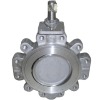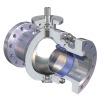A butterfly valve is a valve which can be used for isolating or regulating flow.
Butterfly Valve
A butterfly valve is a valve which can be used for isolating or regulating flow. The closing mechanism takes the
form of a disk. Operation is similar to that of a ball valve, which allows for quick shut off. Butterfly valves are
generally favored because they are lower in cost to other valve designs as well as being lighter in weight,
meaning less support is required. The disc is positioned in the center of the pipe, passing through the disc
is a rod connected to an actuator on the outside of the valve. Rotating the actuator turns the disc either parallel
or perpendicular to the flow. Unlike a ball valve, the disc is always present within the flow, therefore a pressure
drop is always induced in the flow, regardless of valve position.
A butterfly valve is from a family of valves called quarter-turn valves. The "butterfly" is a metal disc mounted on a rod.
When the valve is closed, the disc is turned so that it completely blocks off the passageway. When the valve is fully
open, the disc is rotated a quarter turn so that it allows an almost unrestricted passage of the fluid. The valve may
also be opened incrementally to throttle flow.
There are different kinds of butterfly valves, each adapted for different pressures and different usage. The resilient
butterfly valve, which uses the flexibility of rubber, has the lowest pressure rating. The high performance butterfly valve,
used in slightly higher-pressure systems, features a slight offset in the way the disc is positioned, which increases
the valve's sealing ability and decreases its tendency to wear. The valve best suited for high-pressure systems is the
triple offset butterfly valve, which makes use of a metal seat,and is therefore able to withstand
a greater amount of pressure.
Structure
Butterfly valves are valves with a circular body and a rotary motion disk closure member which is pivotally supported
by its stem. A butterfly valve can appear in various styles, including eccentric and high-performance valves. These are
normally a type of valve that uses a flat plate to control the flow of water. As well as this, butterfly valves are used on
firefighting apparatus and typically are used on larger lines, such as front and rear suction ports and tank to pump
lines.
Types
1.Concentric butterfly valves - This type of valves has a resilient rubber seat with a metal disc.
2.Doubly-eccentric butterfly valves (high-performance butterfly valves or double-offset butterfly valves) -
Different type of materials is used for seat and disc.
3.Triply-eccentric butterfly valves (triple-offset butterfly valves) - The seats are either laminated or solid metal
seat design.
Triply-eccentric (offset) design
Triple eccentric (offset) Design prevents galling and scratches between the metal seat and the metal disc due to
its unique design. The only time where the seal comes into contact with the seat is at the point of complete
closure. Triple offset valves are generally used in applications which require bi-directional tight shut-off in oil
and gas, LNG/NPG terminal and tanks, chemical factories, and shipbuilding. Widely use for dirty/heavy oil to
prevent extrusion.
Wafer-style butterfly valves
The wafer style butterfly valve is designed to maintain a seal against bi-directional pressure differential to
prevent backflow in systems designed for unidirectional flow. It accomplishes this with a tightly fitting seal;
i.e., gasket, o-ring, precision machined, and a flat valve face on the upstream and downstream sides of the
valve.
Lug-style butterfly valve
Lug-style valves have threaded inserts at both sides of the valve body. This allows them to be installed into
a system using two sets of bolts and no nuts. The valve is installed between two flanges using a separate
set of bolts for each flange. This setup permits either side of the piping system to be disconnected without
disturbing the other side.
A lug-style butterfly valve used in dead end service generally has a reduced pressure rating. For example a
lug-style butterfly valve mounted between two flanges has a 150 psi pressure rating. The same valve mounted
with one flange, in dead end service, has a 75 psi rating.
Butterfly Valve












